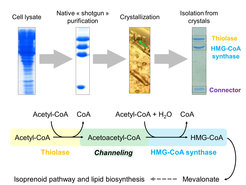Archaea overcome a thermodynamic bottleneck via enzymatic channeling
Mevalonate is a starting material to synthesize many chemicals in industry; it is also the building block of the lipids from all archaea. Scientists at the Max Planck Institute for Terrestrial Microbiology in Marburg and collaborators in France discovered a coupling between the two enzymes responsible for the first step in mevalonate biosynthesis in archaea. This finding explain how archaea can produce mevalonate at high rate to support their growth, and can be applied in industry to optimize mevalonate production.
The archaeal lipid (isoprenoids) synthesis needs mevalonate as a building block. However, the first enzymatic step (thiolase) to generate mevalonate is endergonic, a very slow reaction which is incompatible with the cell requirements (fast growth). So how can archaea grow so fast if they cannot produce lipid precursor at high-speed? To answer this question, the scientists worked with an archaea called Methanothermococcus thermolithotrophicus and isolated from its proteome the thiolase. Surprisingly, the thiolase was combined with two other proteins: one is the next enzyme of the pathway (HMGCS) and the other one acts as a platform (DUF-35 protein family) to gather both enzymes. In a combinational approach of biochemistry and X-ray crystallography the molecular secrets of the high-flux biosynthesis was revealed: the second enzyme is pulling the first reaction using a channeling mechanism. This discovery is of prime importance for industrial application since mevalonate is the building block of many molecules of interests, by using the strategy archaea utilize it may be possible to achieve higher mevalonate production in industrial production strains. But most importantly, this complex seems to be common to the majority of archaea and many bacteria.

Strategy used to isolate and characterize the native thiolase / HMG-CoA synthase complex (top) and the reaction performed by the complex (bottom).
This discovery is the joint effort of the team of Seigo Shima and Tobias Erb from our Max Planck, the Institut de Biologie Structurale (IBS, Grenoble with Eric Girard) and École Normal Supérieure de Chimie in Lyon (ENS, Lyon with Olivier Maury).
Publication:
Vögeli, B.; Engilberge, S.; Girard, E.; Riobé, F.; Maury, O.; Erb, T.; Shima, S. and Wagner, T. (2018)
Archaeal acetoacetyl-CoA thiolase/HMG-CoA synthase complex channels the intermediate via a fused CoA-binding site.
PNAS 2018 Mar 12. pii: 201718649. doi: 10.1073/pnas.1718649115












